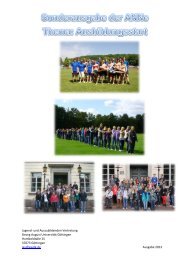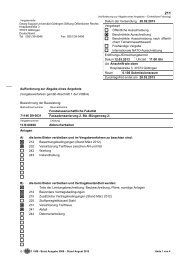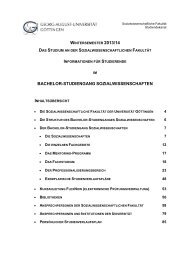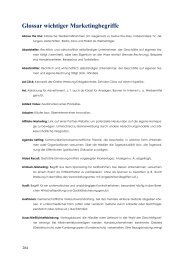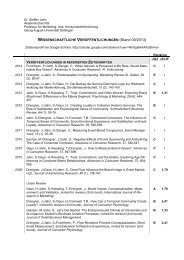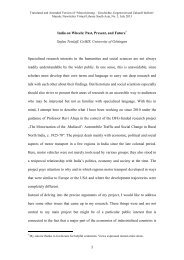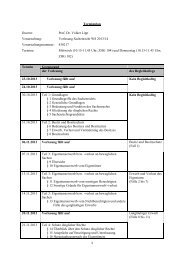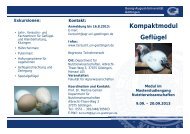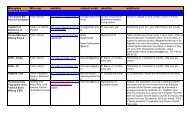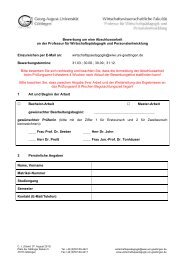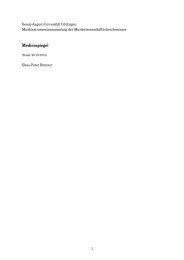CRC 990 - EFForTS - Georg-August-Universität Göttingen
CRC 990 - EFForTS - Georg-August-Universität Göttingen
CRC 990 - EFForTS - Georg-August-Universität Göttingen
Create successful ePaper yourself
Turn your PDF publications into a flip-book with our unique Google optimized e-Paper software.
<strong>CRC</strong> <strong>990</strong> Ecological and Socioeconomic Functions of Tropical Lowland Rainforest Transformation Systems (Sumatra, Indonesia) Issue 1 / <strong>August</strong> 2013<br />
page 20 von 32<br />
on people’s decision-making with regard to land use.<br />
Nowadays, the Harapan lowland transformation system<br />
consists mainly of privately- and state-owned oil palm<br />
plantations (including processing plants), jungle rubber<br />
and plantation rubber, as well as a forest concession of<br />
PT. REKI (PT. Restorasi Ekosistem Indonesia or Ecosystem<br />
Restoration Indonesia) or Harapan Rainforest concession<br />
area. Previously, in the 1970s, almost the entire<br />
Harapan lowland rainforest was farmed out as logging<br />
concessions. Moreover, the whole area has also served<br />
as a region for Indonesian government transmigration<br />
schemes;<br />
more than 80,000 transmigrants, mostly from Java, were<br />
transported there within the framework of clear-cut<br />
agricultural programmes with the allocation of small<br />
plots to families. Thus, from a legal perspective, there is<br />
almost no “free” or private land left. As a consequence,<br />
the land use of individuals and groups is largely predetermined<br />
by the land contracts of the Indonesian government<br />
and the production systems of the contractors<br />
that are geared to the world market.<br />
In sum, the Harapan region is nowadays a renowned<br />
profitable development area especially for concession<br />
holders and the state. It is for this reason that there is<br />
also a continuous influx of migrants who hope to benefit<br />
from the “booming” cash crops, mainly oil palm fruit<br />
and rubber.<br />
According to the policy of the Suharto regime (1965-<br />
1998), the customary land rights of the autochthonous<br />
or indigenous inhabitants of the area, Batin Semiblan,<br />
who had been living in and with the forest for many<br />
generations if not centuries, have never been acknowledged<br />
nor have they benefitted from the profit the government<br />
and companies made. These communities and<br />
their claims for the restitution of their customary land<br />
are currently supported by national and international<br />
NGOs. The struggle to gain access to land and have<br />
customary land rights acknowledged by the state has<br />
given rise to many conflicts. Different forms of cultural<br />
knowledge and practices or ethnicity are not, therefore,<br />
decisive factors with regard to the nature of land use.<br />
The difficulty of gaining access to land and/or labour<br />
(for example, as a plantation or factory worker) bridges<br />
cultural or religious differences and leads to new alliances<br />
and strategies, that range from strategic marriages of<br />
immigrants with indigenous people and the reselling of<br />
undocumented land plots, to occupation of concession<br />
land.<br />
C07<br />
Title: Land use changes among smallholder farmers<br />
of Jambi<br />
Province: Initial insights from the household survey<br />
authors: Vijesh Krishna, Michael Euler, Hermanto Siregar,<br />
Zakky Fathoni, Stefan Schwarze, Matin Qaim<br />
The household survey under sub-project C07 was successfully<br />
completed by December 2012. The overall goal<br />
was to understand the micro-level factors determinants<br />
behind the recent land use changes in<br />
lowland rainforest areas of Jambi, and<br />
also to quantify their impacts on the welfare<br />
of smallholder farm households. For the survey, five<br />
regencies of Jambi were selected purposively: Sarolangun,<br />
Batanghari, Muaro Jambi, Bungo and Tebo. These<br />
regencies comprise most of the lowland transformation<br />
systems of the province.<br />
A stratified sampling approach was employed for<br />
household selection. Households from 40 randomly<br />
and 5 purposively selected villages form the sample.<br />
Following the village selection, a complete list of households,<br />
from each of the selected villages, was collected<br />
from the village/dusun/neighborhood heads. Significant<br />
diversity was found across the selected villages<br />
with respect to a number of socio-economic characteristics,<br />
especially ethnicity and number of households<br />
residing in the village. The available secondary data<br />
(e.g., the Village Potential Statistics or PODES) support<br />
this observation.<br />
Due to the significant variation in village population,<br />
sampling a constant number of farmer households per<br />
village would critically under-represent the households<br />
from bigger villages and over-represents those from<br />
smaller villages. To reduce the severity of this problem,<br />
we divided the randomly selected villages into four<br />
quarters based on the population size. Only 6 households<br />
were selected from each of the 10 villages that<br />
came in the lowest quartile with respect to village size,<br />
12 per village from the second quartile, 18 per village<br />
www.uni-goettingen.de/de/310995.html • crc<strong>990</strong>@gwdg.de • Telephone: +49 551 39-1 21 18<br />
JFB Institute for Zoology & Anthropology • Berliner Strasse 28 • D-37073 <strong>Göttingen</strong>




